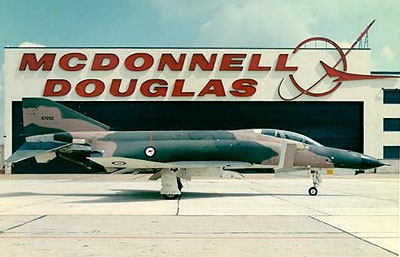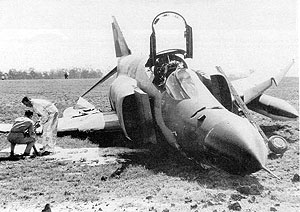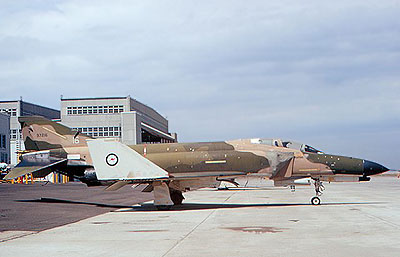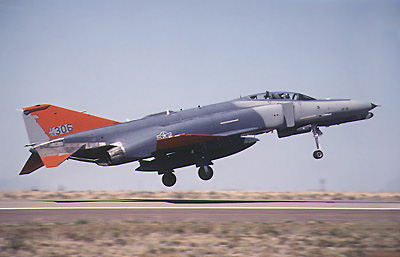 Aussie
F-4s
Aussie
F-4s
Bob La Roche and Gary Parsons look at the brief tenure of the Phantom by the RAAF. Pictures by Mark Richardson unless credited otherwise.
The F-4 Phantom is well renowned for serving with many foreign air forces and being a major export success for the USA, but its brief service with the Royal Australian Air Force (RAAF) is less well-known and seems to have been (well, almost) a well-kept secret, though, of course, it wasn't! Looking back, a perception is one of desperation by both the Australian and US Governments at the non-delivery of the F-111C.
From the Australian perspective, it was getting desperate. In March of 1963, McDonnell had tried to interest the Royal Australian Air Force (RAAF) in a version of the F-4C powered by a pair of French-built SNECMA Atar 9 turbojets (chosen because it powered the Dassault Mirage III fighters that were already being flown by the RAAF). However, the RAAF decided to opt for the General Dynamics F-111C, but the development of the F-111 turned out to be much more difficult than expected, the program suffering from numerous problems and delays. The serious problems encountered with the USAF's F-111A resulted in a long-term postponement in the deliveries of the F-111Cs to Australia - the biggest problem with the F-111 was the failure of the swing wing torsion box, which was impacting on US Air Force deliveries, not to mention to the RAF, which eventually cancelled its order for the F-111K. In May of 1970, it was announced that deliveries of F-111Cs to the RAAF could not be expected until 1974.

 1
and 6 Squadrons were then still equipped with Canberra, and following
intensive operations in Vietnam, were fast running out of flying hours.
To fill the shortfall, in 1970 the US Government offered to lease the
RAAF 24 new build F-4Es from USAF stocks at heavily discounted rates under
Project 'Peace Reef'. This was accepted reluctantly at the time by the
Australian government. In fact, the planes retained their USAF serial
numbers throughout their time here, the only obvious visible difference
being the application of RAAF markings. They served at Amberley, Brisbane,
replacing the Canberra bombers and were assigned the out-of-sequence serial
prefix 'A69' (previously assigned for the first ten planes of a cancelled
order for Curtiss A-25 Shrikes during the Second World War), chosen so
that it matched the FY of the USAF serial numbers. They served well until
1972 and were popular with both air and groundcrew who liked the aircraft's
characteristics and servicing ease - well, when compared with the Canberra,
but with one hazardous exception! Following many scalp injuries sustained
by ground staff when working under the aircraft, a directive was enforced
that all servicing crew should wear hard hats. The multiplicity of antennae
and other bits under the fuselage made effective guillotines!
1
and 6 Squadrons were then still equipped with Canberra, and following
intensive operations in Vietnam, were fast running out of flying hours.
To fill the shortfall, in 1970 the US Government offered to lease the
RAAF 24 new build F-4Es from USAF stocks at heavily discounted rates under
Project 'Peace Reef'. This was accepted reluctantly at the time by the
Australian government. In fact, the planes retained their USAF serial
numbers throughout their time here, the only obvious visible difference
being the application of RAAF markings. They served at Amberley, Brisbane,
replacing the Canberra bombers and were assigned the out-of-sequence serial
prefix 'A69' (previously assigned for the first ten planes of a cancelled
order for Curtiss A-25 Shrikes during the Second World War), chosen so
that it matched the FY of the USAF serial numbers. They served well until
1972 and were popular with both air and groundcrew who liked the aircraft's
characteristics and servicing ease - well, when compared with the Canberra,
but with one hazardous exception! Following many scalp injuries sustained
by ground staff when working under the aircraft, a directive was enforced
that all servicing crew should wear hard hats. The multiplicity of antennae
and other bits under the fuselage made effective guillotines!
 The
RAAF crews liked their F-4Es, so much so in fact that Australia at one
time seriously considered cancelling its order for the F-111Cs and buying
the Phantoms instead. This turned out not to be cost effective, since
Australia would also have had to purchase a fleet of KC-135 tankers to
support the Phantoms.
The
RAAF crews liked their F-4Es, so much so in fact that Australia at one
time seriously considered cancelling its order for the F-111Cs and buying
the Phantoms instead. This turned out not to be cost effective, since
Australia would also have had to purchase a fleet of KC-135 tankers to
support the Phantoms.
One was lost (69-7203) off Evans head, during gunfire trials. One other (69-7234) was badly damaged in a perfect arrester landing at Amberley (their home base in Queensland), when the wire broke and sent the plane skidding off the runway (left). It was touch and go as a repair proposition, but with the help of the Americans, the plane was rebuilt here, and rejoined the fleet in time to be returned to the US.
|
Airshow
regular
|
 |
With the imminent delivery of the first batches of F-111C, accompanied by KC-135 tankers, the 23 F-4s were ferried back to the US, using the same tankers. The Australian Government was approached with a bargain basement offer to keep the Phantoms, but to the disappointment of the operators, declined. Six RAAF F-4Es were returned to the USA in October of 1972 and the long-awaited F-111Cs finally began to arrive in Australia in June of 1973, the last RAAF F-4E being returned to the USA by 21 June 1973. My understanding is that the ex-Aussie planes were flown to Hill AFB, where most were converted to F-4G Wild Weasel configuration, to help the war effort in Vietnam. Some eventually found their way to the 52 TFW, based at Spangdahlem, Germany and were regular airshow attendees in Europe during the '80s and early '90s.
 The
post script is that, following extended delays, the F-111C has proved
a brilliantly effective weapons delivery system. The initial 24 ordered
have been reduced by accident attrition, but following the withdrawal
of the F-111G from the USAF inventory, the RAAF purchased 15 second-hand,
providing a theoretical force of some 30 planes...all upgraded. As the
RAAF was the only export customer for the F-111, it is now is the only
force in the world to operate these awesome weapons. Indonesia is acutely
aware of its strike power.
The
post script is that, following extended delays, the F-111C has proved
a brilliantly effective weapons delivery system. The initial 24 ordered
have been reduced by accident attrition, but following the withdrawal
of the F-111G from the USAF inventory, the RAAF purchased 15 second-hand,
providing a theoretical force of some 30 planes...all upgraded. As the
RAAF was the only export customer for the F-111, it is now is the only
force in the world to operate these awesome weapons. Indonesia is acutely
aware of its strike power.
 Serials
of F-4E Phantoms delivered to Australia:
Serials
of F-4E Phantoms delivered to Australia:
69-0304, 69-0305, 69-0306, 69-0307, 69-7201, 69-7202, 69-7203, 69-7204,
69-7205, 69-7206, 69-7207, 69-7208, 69-7209, 69-7210, 69-7211, 69-7212,
69-7213, 69-7214, 69-7215, 69-7216, 69-7217, 69-7219, 69-7220, 69-7234.
